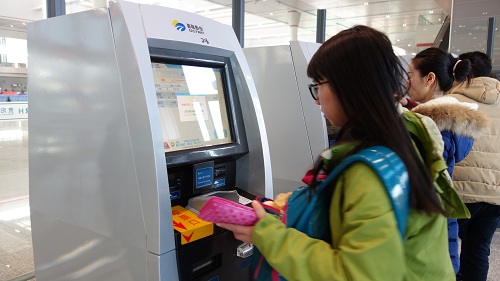Like an airplane ticket, all your boarding information is printed on your China train ticket. It would be easier to board the train if you can understand some of the essential information on your ticket, such as your train number, carriage number, and seat number.
Don’t understand a single Chinese character? Don’t worry, this article will teach you how to understand the key information on the Chinese train ticket.
Types of the Chinese Train Tickets
There are two kinds of tickets in China, blue tickets and red tickets. They are assigned at random, mainly depending on which kind of ticket paper is put in the automatic ticket machines. But generally, blue tickets have a larger circulation.

The automatic ticket checking machines
- The blue tickets are magnetic. If you hold a blue ticket, you can line up in front of the automatic ticket machines when boarding. You just need to put your ticket into the machine and the door will automatically open.
- The red tickets have no magnetism and can only be checked by station attendants. If you hold a red ticket, please line up near the automatic ticket machines, there will be a station attendant checking these red ones.
The Translation of Chinese Train Tickets
Here is a picture of the translation for both blue ticket and red ticket:

As we can see, the contents of blue ticket and red ticket are the same.
You don’t need to understand all the information on the ticket. In the picture above, we only listed four parts that are used most commonly:
① Departure Station & Arrival Station: The departure and arrival station are wrote in both Chinese and English. But please notice that the train station name in English is Chinese pinyin spelling. From the picture above, the “Nanning East Railway Station” is wrote as “Nanning dong”, because “east” is called “dong” in Chinese. The picture above gave all the Chinese spelling for east, west, south, and north.
② Departure Time: The departure time is also wrote in Chinese, and it is ordered by year, month, and date. For example, “2018年07月31日” means the departure time is “July 31, 2018”.
③ Train Number: The number between your departure and arrival station is your train number. Please confirm that you board the right train with this train number.
④ Seat Class: Right beneath the arrival station, you can find your seat &carriage number and seat class. The first line is your seat number, and it is ordered by carriage number and seat number. For example, “02车05A号” means that you will sit in “Carriage no.2, Seat 05A”.
In the second line, which is under the your seat &carriage number, you can find your seat class. It is wrote in Chinese and you can find the translation in the above picture. But sometimes you don’t need to understand it, since it is not hard to remember your seat class when booking tickets online previously.
⑤ Seat Class (for sleeper berth): the second ticket of the picture is a sleeper train ticket. So the seat class part is printed your sleeper berth information. It is ordered by carriage number, sleeper number, and sleeper position. For example, “11车017号下铺” means “Carriage no.11, sleeper no.017, lower sleeper”. You can find out the translations for lower, middle, and upper sleeper in the above picture.
Some tickets also have the check-in gate number printed on the upper right corner:

This means that you don’t need to find the check-in gate on the LED screen at the station, you can directly go to the right check-in gate.
However, most tickets (especially normal-speed train tickets) don’t have the check-in gate number printed on them. In that case, you need to find your check-in gate by your self.
Book Your China Train Ticket
To find out how to buy a China train ticket from the station or via the internet, please read How to Buy a China Train Ticket.
Or you can simply download our China Train Booking app to get you ticket(s) within 3 minutes after making the payment.
We now support English, German, Japanese, Italian, Russian and Spanish version.





